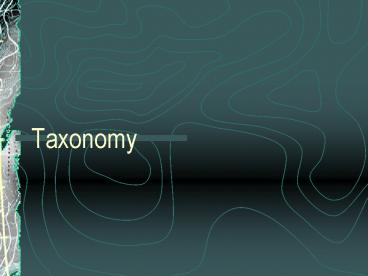Taxonomy PowerPoint PPT Presentation
1 / 23
Title: Taxonomy
1
Taxonomy
2
(No Transcript)
3
(No Transcript)
4
(No Transcript)
5
Prokaryotes
6
Prokaryotes
- Microscopic
- No membrane bound nucleus or organelles
- Single-celled organisms that can be colonial
- Contains two domains Bacteria and Archaea
- Can be found in most areas of the world even in
Antarctica
7
Archaebacteria
- Prokaryotes
- Always unicellular
- Found in extreme environments such as hot boiling
water and thermal vents - Have several different cellular chemistries from
eubacteria
8
Eubacteria
- Prokaryotes (no nucleus)
- Always unicellular (single-celled)
- Bacteria
- May have plant, fungus, or animal
characteristics. - Different make up than archaebacteria
9
Eukaryotes
10
Eukaryotes
- Can be divided into four types of organisms
Protists, Fungi, Animals, and Plants - Protista- contains several kingdoms that are
very diverse - Most are multicellular
- Can be heterotrophs, or autotrophs, free-living
or parasitic - Can be freshwater or marine
- Vast morphology of forms
11
Protista
- Protista- contains several kingdoms that are
very diverse - Most are unicellular
- Can be heterotrophs, or autotrophs, free-living
or parasitic - Can be freshwater or marine
- Vast morphology of forms
12
Protista
13
Protists
- Diverse group of mostly unicellular organisms
- Algae- protists that synthesize their own food
- Protozoa- eat bacteria and other protists
- Can be multicellular
- Most are aerobic, but some are anaerobic
- First ones arose from prokaryotes, and gave rise
to all plants, fungi, and animals as well as to
all modern protists
14
Protozoa
- Protists that live primarily by digesting food
- Eat bacteria and other protists
- Flagellates
- Giardia- parasitic intestinal flagellate
- Free- living
- Amoeba- free-living, moves and eats by way of a
pseudopodium
15
Protozoa
- Apicomplexans-
- Parasitic, organelles specialized for invading
hosts - Plasmodium malaria
- Ciliates-
- Use cilia to move and feed, usually free-living
- Paramecium
16
Cellular Slime Molds
- Slime molds are protists that may constitute a
distinct kingdom - Can exist in both unicellular and multicellular
forms
17
Plasmodial Slime Mold
- Unicellular
- Has many nuclei in one very large plasma membrane
- Can be differentiated into reproductive structure
as well
18
Chromista
- Photosynthetic protists
- May be treated as a separate kingdom or included
among the Protista - Algae whose chloroplasts contain chlorophylls a
and c, as well as various colorless forms that
are closely related to them - Algae, diatoms and seaweed
www-biol.paisley.ac.uk/ biomedia/gallery/cerat.htm
www.pac.dfo-mpo.gc.ca/.../ Biotoxins/PSP_e.htm
19
Algae
- Diatoms
- Unicellular
- Silica cell wall, two halves
- Green Algae
- Unicellular algae
- Cell walls
- Can form colonies
- Can have flagella
20
Seaweed
- Multicellular marine algae
- Lack the structural specializations of plants
- Brown algae
- Related to diatoms
- Red algae
- May be classified in a different kingdom
- Green algae
- Has a sequence of life cycles
21
Plantae
- Multicellular
- Autotrophs
- Flowering plants, ferns, and mosses
- Second largest kingdom
- Plant species range from the tiny green mosses to
giant trees.
22
Fungi
- Eukaryotes
- Almost all multicellular
- Must obtain complex food molecules from external
source, absorbed through external surface - Almost never capable of movement.
23
Animalia
- Largest kingdom with over 1 million known species
- Multicellular
- obtain complex food molecules from external
source, broken down and absorbed internally - Usually capable of movement.

